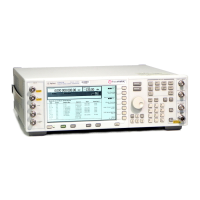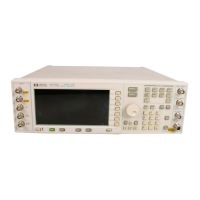396 Chapter 14
Real Time TDMA Formats
Enhanced Observed Time Difference (E-OTD)
To make the trigger to TO measurement it is necessary to send the following command using the remote
interface:
:READ:PVT10?
The READ command performs an INIT followed by a FETCH so a new measurement is started each time.
With no averaging the standard deviation should be approximately 4ns for the ESG and 9ns for the 8960.
For this set up the ESG uses a continuous triggering mode, trigger and run. In this mode the ESG waits for a
trigger pulse, then runs and ignores any further trigger pulses.
//Send the following commands to set the trigger mode:
:RADio:GSM:TRIGger:TYPE:CONTinuous TRIG
:RADio:GSM:TRIGger EXT
:RADio:GSM:TRIGger:TYPE CONT
//The ESG is set up to have a non-combined BCH in slot 0 and a normal TCH on slot 2
:RADio:GSM:SLOT0:NORMal ENCRyption BCH1
:RADio:GSM:SLOT2:TYPE:NORMal
:RADio:GSM:SLOT2:NORMal:ENCRyption PN9
At this point the ESG is waiting for a trigger. Sending a CALL statement to the 8960 resets the frame
counters and sets a single trigger at the beginning of the multiframe. Now both the 8960 and the ESG are
running together but not perfectly aligned.
:CALL:TRIG:OUTP:FRAM:SYNC
Measure the trigger to TO for each. If the 8960 is the first burst then it is necessary to restart the system with
a symbol offset applied to the trigger.
Send the following commands to make the ESG ready and align the ESG with the 8960:
:RADio:GSM:TRIGger:TYPE:CONT
:CALL:TRIG:FRAM:SYNC:OFFS xx (where xx is the number of symbols to advance the trigger)
:RADio:GSM:TRIG:EXT:DEL:FINE yy (where yy is the fraction of a symbol necessary for perfect
alignment)
The last command is a call to the 8960 to start up again. Now both bursts should be in alignment and the
frame counters reset.
:CALL:TRIG:OUTP:FRAM:SYNC

